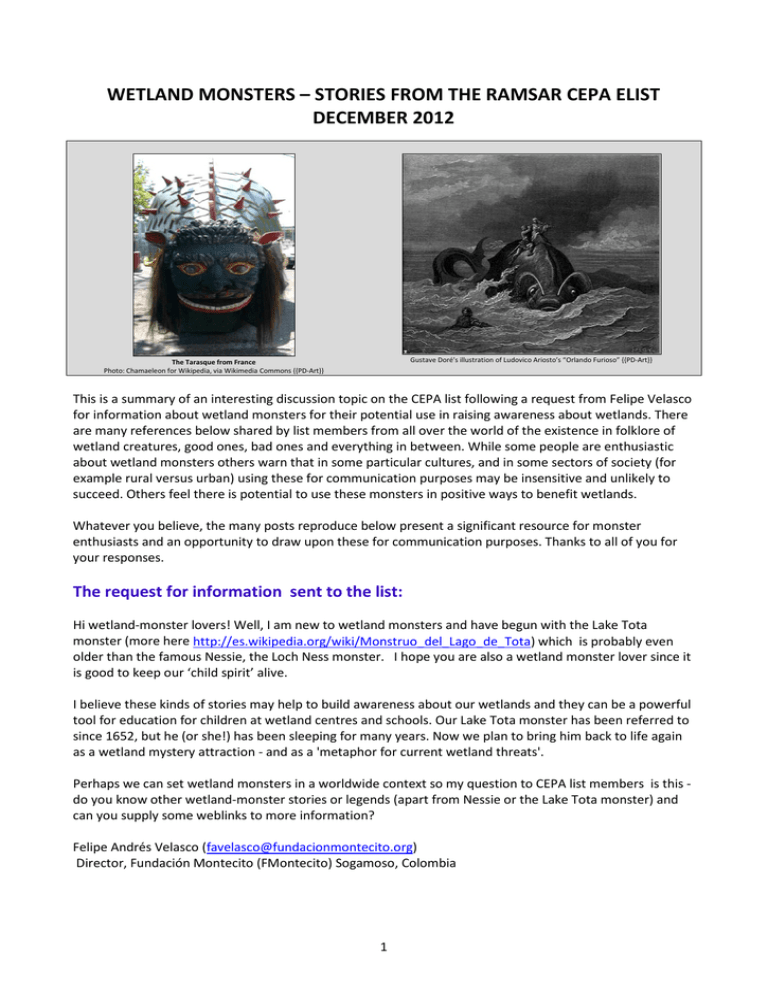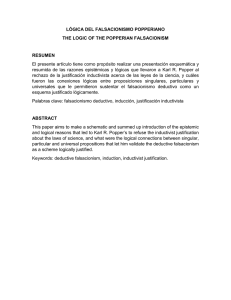wetland monsters – stories from the ramsar cepa elist december 2012
Anuncio

WETLAND MONSTERS – STORIES FROM THE RAMSAR CEPA ELIST
DECEMBER 2012
Gustave Doré’s illustration of Ludovico Ariosto’s “Orlando Furioso” {{PD-Art}}
The Tarasque from France
Photo: Chamaeleon for Wikipedia, via Wikimedia Commons {{PD-Art}}
This is a summary of an interesting discussion topic on the CEPA list following a request from Felipe Velasco
for information about wetland monsters for their potential use in raising awareness about wetlands. There
are many references below shared by list members from all over the world of the existence in folklore of
wetland creatures, good ones, bad ones and everything in between. While some people are enthusiastic
about wetland monsters others warn that in some particular cultures, and in some sectors of society (for
example rural versus urban) using these for communication purposes may be insensitive and unlikely to
succeed. Others feel there is potential to use these monsters in positive ways to benefit wetlands.
Whatever you believe, the many posts reproduce below present a significant resource for monster
enthusiasts and an opportunity to draw upon these for communication purposes. Thanks to all of you for
your responses.
The request for information sent to the list:
Hi wetland-monster lovers! Well, I am new to wetland monsters and have begun with the Lake Tota
monster (more here http://es.wikipedia.org/wiki/Monstruo_del_Lago_de_Tota) which is probably even
older than the famous Nessie, the Loch Ness monster. I hope you are also a wetland monster lover since it
is good to keep our ‘child spirit’ alive.
I believe these kinds of stories may help to build awareness about our wetlands and they can be a powerful
tool for education for children at wetland centres and schools. Our Lake Tota monster has been referred to
since 1652, but he (or she!) has been sleeping for many years. Now we plan to bring him back to life again
as a wetland mystery attraction - and as a 'metaphor for current wetland threats'.
Perhaps we can set wetland monsters in a worldwide context so my question to CEPA list members is this do you know other wetland-monster stories or legends (apart from Nessie or the Lake Tota monster) and
can you supply some weblinks to more information?
Felipe Andrés Velasco (favelasco@fundacionmontecito.org)
Director, Fundación Montecito (FMontecito) Sogamoso, Colombia
1
The responses from CEPA list members
1. Grégoire Macqueron - zhi-gzh@snpn.fr
Chargé de mission Zones humides, Zones Humides Infos
Correspondant ONG pour la CESP de Ramsar en France
The first marsh monster which come to my mind is the Lernaean Hydra, killed by Heracles
(http://en.wikipedia.org/wiki/Lernaean_Hydra).
In France, we also have the Tarasque (http://en.wikipedia.org/wiki/Tarasque) , the Gargouille of Rouen
(http://www.france-pittoresque.com/spip.php?article440) and many others dragons & vouivres which lived
in marsh and was killed by saint people most of the time.
In french, a festival monstrously funny where monsters are invited to Leman Lake: “Eaux monstres” (a pun
between “water monster” and “Help! Monster”).
http://www.eaux-monstres.com/uploads//images/Presse%20_%20Dossier.pdf
I don’t know if it can be useful, but there are many stories in France on such monsters.
************************************************
2. David A. Stroud - David.Stroud@jncc.gov.uk
Senior Ornithologist, UK Joint Nature Conservation Committee
And don’t forget Swamp Thing!
http://en.wikipedia.org/wiki/Swamp_Thing
***************************************************************
3. Harban Singh, Malaysia - harbansingh88@gmail.com
While this monster thing sounds interesting & maybe a way to attract more visitors to the wetlands watch
the reverse too. In some nations and cultures, people are very superstitious & monsters may be a taboo
word and because of the "adverse effect of monsters perception" may even stop visiting wetlands.
Be discerning & discreet huh!!
*************************************************
4. Namakula Regina Ceali - ceali22@gmail.com
CEPA Gov Focal Point, Wetlands Management Department, Uganda
In my case I am still establishing the equivalent of Wetland Monsters in Africa and particularly in Uganda
and how it would impact on our young generation.
The impact may defer depending on the background of the 'audience'. While some in the urban setting and
in high class life may have fun getting such story, a person from the rural setting may respond different.
BUT-this is worth trying and testing. Am also waiting to hear from other folk.
************************************************
5. Jenny Lonnstad - jenny.lonnstad@naturvardsverket.se
CEPA Gov Focal Point, Advisor, Swedish Environmental Protection Agency
In Sweden we have the monster ”Storsjöodjuret” (literally “The Great-lake monster”) living in Storsjön (the
great lake). The first written record is from 1635, but the legend is probably older. The monster has also
been a locally protected species by a legal decision 1986-2005!
http://en.wikipedia.org/wiki/Storsj%C3%B6odjuret (in English, with links to other monsters)
2
http://www.jamtli.com/8169.storsjoodjuret.html (translation to a number of languages, choose in the box
where it says “svenska”, unfortunately the name of the languages is in Swedish but they are often similar to
the English ones, Spanish=spanska.
http://www.ungafakta.se/mysterier/monster/sjoodjur-fler.asp# (the site include a number of wetlands
monsters, unfortunately in Swedish but names of lakes, monsters and countries might be identified)
***************************************************
6. Stefan Bohórquez G. - stefan_bohorquez@yahoo.com
Punto Focal Civil Ramsar, Ecuador
Existe en Ecuador un complejo de lagunas alto-andinas conocidas como Ozogoche y situadas dentro del
Parque Nacional Sangay- donde no se habla de un monstruo, pero sí de leyendas acerca del suicidio que
cometen pájaros migratorios –conocidos acá como Cuvivíes (Bartramia Longicauda)- en ofrenda a SUPAY,
el Dios-Diablo de los indígenas de la zona, siempre la tercera semana del mes de septiembre.
Estas leyendas son anteriores a a conquista de nuestros territorios por los españoles y algunas versiones
cuentan de columnas de aguas que se levantan para capturar en vuelo a las aves.
Lo cierto es que ese fenómeno ocurre cada año en las lagunas de Ozogoche y la explicación tiene que ver
con la fatiga que sufren las aves en el páramo ecuatoriano, cuando ascienden a más de 3.800 metros de
altura, en su viaje hacia Chile. Los indígenas de la zona han establecido rituales acerca de este evento y
recogen las ves que llegan flotando hasta las orillas para su alimentación, como si fuese una ofrenda, a su
vez, que hacen los dioses a los habitantes de la zona.
Fragmento de un relato de ancianos del lugar:
“A mediados de septiembre se daba el día del tributo sagrado. El cielo se tornaba gris y en los montes, el
sonido del viento se opacaba con los aullidos del lobo; el supay (diablo) se quejaba como ashcu (perro). De
pronto surcaban el espacio cientos de cuvivíes (aves) con su inconfundible canto de dolor y, en un instante
indeterminado, se precipitaban a las heladas aguas en un tributo ancestral, cósmico y misterioso. A la
mañana siguiente, los campesinos recogían en canastas y costales los cuerpos de las aves suicidas de las
orillas de las lagunas del Cuyo, Atillo y Ozogoche”.
************************************
7. Shelley Cant-Woodside - scant@bnt.bs
Bahamas National Trust
I have to agree with the concerns raised by Harban Singh from Malaysia. I try very hard to reduce the
negative impacts that these “monster” stories have had on the perception of wetlands and blueholes in the
Bahamas. People regard them as dangerous places that should either be filled in or caged from the public.
In our country there is a bit of a culture where parents tell children horrifying stories about natural areas to
keep them away from these places, it is used as a form of control. As a result it has had a negative
perception on wilderness as a whole. It is something that I have to counteract every day.
******************************************
8. Kim Diana Connolly - kimconno@buffalo.edu
CEPA Gov Focal point, Professor of Law, SUNY Buffalo Law School, NY, USA
What an interesting discussion!
Here in the United States (where I am honored to serve on the US National Ramsar Committee) there is a
lot of anti-wetland rhetoric at a political level. I would wonder if a public discussion of fanciful wetland
monsters would serve to intrigue people/voters, or be used as part of the negative campaign against these
valuable resources in some way.
*********************************************************
9. Michèle Sato - michelesato@gmail.com
3
Grupo Pesquisador em Educação Ambiental, Comunicação e Artes - GPEA, Brazil
in the brazilian amazonian there is a big snake called ANACONDA - mainly in the amazon river. most of
people tell terrible histories about it, however, local communities believe it protects the water.
here in mato grosso, also amazonia, but there is another ecosystem called pantanal (brazilian wetland ramsar) there is a huge worm called MINHOCÃO (big worm). people tell us it also protects the water.
there many other mythologies, but in relation to monster and water ANACONDA and MINHOCÃO are very
traditional. you may find some pictures and histories (portuguese) at:
http://mimisato.blogspot.com.br/search/label/mythology
legends, myths and folks in brazil USUALLY help the nature, they are all connected and benefit the
environment. even the monster, they are scared to the people who destroy the nature.
i work with indigenous mythology and for them, myth is not a lie -- neither children story. for the
indigenous, myth is existence. the cosmologies and believes based on myth are VERY MUCH important!
besides, the myth helps to give a sort of mystery and may call the attention of the tourists. well, at least in
brazil!
********************************************************
10. Christine Prietto - christine.prietto@gmail.com
CEPA NGO Focal Point, Australia
What about Kappa, the Japanese River Monster?
http://en.wikipedia.org/wiki/Kappa_(folklore)
**************************************************************
11. Brij Gopal - brij44@gmail.com and D.P. Zutshi
India
In India, according to a legend, Kashmir valley was originally a lake, known as “Satisar”. In the lake resided a
(monster) demon ‘Jalodbhava’ who caused great distress to people in the neighbourhood. People
requested the sage, Rishi Kashyap to save them from the demon. The sage cut a deep gorge in the
northwest and drained the lake, eventually killing the demon. Later, the descendants of Kashyap Rishi
inhabited the valley that was hence named Kashmir.
*********************************************************
12. Rebecca D’Cruz – dcruz.rebecca@gmail.com
Malaysia
Here in Malaysia, we have our own lake monster in the country's second largest natural lake:
Chini Lake
http://en.wikipedia.org/wiki/Chini_Lake
Tasek (Lake) Chini Giant Snake
http://cryptozoo-oscity.blogspot.com/2009/10/tasek-chini-lake-giant-snake.html
***************************************************
13. Shirley Bethune – bethune@iway.na
CEPA NGO Focal Point, Namibia
4
We don’t [have water monsters] but I know Sweden does in a lake near Orsa I think, maybe a Swede can
give you the details - they even have a young one in a jar in the museum ... Regards from Namibia, the land
of dry lakes.
***********************************************
14. Guillermo Federico Lingua - glingua@ambiente.gob.ar
CEPA Government Focal Point, Grupo de Trabajo sobre Recursos Acuáticos, Coordinador, Argentina
Aquí les adjunto un link a una página que describe muy bien la situación de nuestro “Nahuelito” o como lo
llamaban los habitantes originarios “El Cuero”; un misterioso monstruo que habita o habitaba en el Lago
Nahuel Huapi (Provincias de Río Negro Neuquén, Argentina).
http://animalderuta.wordpress.com/2010/08/14/la-leyenda-del-nahuelito/
***********************************************
15. Katie Belfuss – wwaprogs2@wisconsinwetlands.org
Wisconsin Wetlands Association, USA
Thanks for offering to put together a summary of the responses to this monster post. I'll be glad to have
that, as I'm working to find someone to write an article for our newsletter about these posts for our
Halloween newsletter issue next fall. How fun! Interesting how different (yet how similar) some of these
traditions are.
***********************************************
16. Patrick Lynch - lynch.pj@gmail.com
Executive Director, FUTALEUFÚ RIVERKEEPER, http://www.futaleufuriverkeeper.org/
Como dijo Guillermo, tenemos acá en Chile tanto en Argentina la historia del Cuero, que se llama en
mapundungun Trelke Wekufe. Claro que hay una discurso amplio sobre el origen de este monstruo, pero
por ahora es muy conocido por todo lado en esas zonas.
También el autor Austin Whittall publicó un articulo en inglés sobre El Cuero y otras especies en la
Patagonia: http://patagoniamonsters.blogspot.com/2010/01/all-you-ever-wanted-to-know-aboutcuero.html.
Entre otros puntos que vale la pena mencionar, creo que uno que puede ser muy importante de ampliar es
el punto que hay muchos lugares (humedales, ríos, lagos aislados como en la cordillera de los Andes) que
son muy pocos investigados, por eso existe varias leyendas y explicaciones no científicos que a veces duran
por siglos en la conciencia y la cultural de la zona y da su fuerza a los sueños de asimismo. Entonces la idea
de cada 'monstruo' puede ser un tesoro para un país incluso si es peligroso o da miedo a la gente, creo que
es muy fuerte, porque ofrece una oportunidad de que llega otra gente del extranjero para investigarlo y ver
con sus propios ojos cual es la situación real. Cada país debe celebrar esos monstruos y diseminar las
historias, para fortalecer la investigación y colaboración en desarrollar y proteger sus zonas acuáticas junto
con académicos, artistas y otros profesionales hasta todo tipo de aventurero. Igual nosotros como
ambientalistas podemos pensar en como podemos lograr nuestros objetivos de conservación y protección
ambiental gracias a los monstruos los cuales habitan en los cuerpos de agua.
************************************************
17. Rahat Najam - rahatjabeen69@gmail.com
Environment specialist, WSIP-PCMU, Pakistan
We have many wetland monsters and legend stories like one beautiful lake in northern areas of Pakistan.
Lake safe ul mulk which is called as fairy mountains lakes. It is a myth that on 14th of every full moon the
5
fairies coming down in the lake and perform dances. Locals reported that they are witnessed. Many newly
married couples try to visit this lake as honey moon place. It still has magical beauty. Beside that it is the
myth that blind river indus dolphin was a beautiful women and she was punished By head of village and she
become blind dolphin. I will search similar other stories will share with all colleagues.
************************************************
18. Jorge Liotta - jliotta@fundacionoga.org.ar
Museo de Ciencias Naturales, Buenos Aires, Argentina, https://sites.google.com/site/museoscasso/
Quisiera compartir con ustedes otra historia de monstruos de humedales. Ésta es una ampliamente
conocida, y que goza de buena salud en la cultura ribereña del río Paraná.
Se trata del Yaguarón, ser gigante con cabeza de perro, cuerpo de serpiente y cola de pez, que habita en
cuevas bajo el río. Provoca derrumbes y devora animales y personas. Emite profundos bramidos y rugidos.
Encontrarán muchas referencias en la web.
Es tan emblemático en nuestra región, que en la ciudad donde vivo (San Nicolás de los Arroyos), tenemos
un arroyo, un barrio, un grupo de ballet, un hotel y un restaurante con ese nombre. El “monstruo” ha dado
tema además, a varias exposiciones de plástica, poemas, novelas y aun excelentes obras de títeres.
Varios autores narran la leyenda, y destaco sobre todo un libro generado por la Fundación Óga: “Mitos y
leyendas del río, el campo y la ciudad”, de Damián Voglino (Editorial Continente). En él se transcriben
entrevistas hechas por el autor a pobladores de la región, quienes relatan experiencias y encuentros
referidos a éste y a otros seres de los humedales del delta del río Paraná.
Todos los años, una cantidad de docentes utilizan a la leyenda del Yaguarón como material para sus clases,
y muchos escolares disfrutan de la narración de la historia en las visitas guiadas que efectuamos en el
Museo de Ciencias Naturales "Rvdo. P. Antonio Scasso".
Una aclaración: no creo que debamos reducir estos elementos a ser parte de nuestro “espíritu infantil”.
Temo que catalogando de este modo a los seres sobrenaturales de los humedales no logremos más que
caricaturizarlos, y desperdiciemos así uno de nuestros vínculos ancestrales y profundos con los ambientes
regionales. Muchas representaciones y seres forman parte de las culturas de los pueblos originarios, así
como de la nuestra (criolla), y opino que deben ser respetados como tales.
19. Makiko YANAGIYA - MAKIKO_YANAGIYA@env.go.jp
CEPA Gov Focal Point, Nature Conservation Bureau, Japan
Just for your reference,
Here in Japan, we have “Kappa” as the original monster lives in wetland.
http://en.wikipedia.org/wiki/Kappa_(folklore)
**********************************************************************
20. Irina Kammenova - IKamennova@wwf.ru
CEPA NGO Focal Point, WWF Russia
There is an interesting list of various creatures, both good and evil in regard to human beings, inhabiting
wetlands all over the world: http://en.wikipedia.org/wiki/List_of_piscine_and_amphibian_humanoids
Perhaps, it is not even complete. I know that in Slavic mythology, there are also creatures who live in
peatlands called ‘bolotnik’, ‘bagnik’, ‘orzhavinik’ and ‘virovnik’.
************************************************
21. Nathalie Fearon - nfearon@nepa.gov.jm
CEPA Gov Focal Point; Manager, Public Education and Corporate Communication
National Environment and Planning Agency
6
Jamaican folklore includes River Mumma, a female water spirit who it is said guards the source of many of
our rivers. She may sometimes be seen sitting on a rock in the river, combing her hair with a golden comb.
She sometimes leaves her comb on a rock, to entice victims whom she then draws into the water.
During slavery, sacrifices were made to the River Mumma in times of drought, or when someone wanted to
cross the river she was guarding. The fish form that part of the river would not be eaten, as these were said
to be her children. River Mumma is often associated with the legend of the Golden Table, one of the
popular Jamaican folk tales.
The Legend of the Golden Table states that a table of pure gold lies at the bottom of certain rivers, usually
at the river head (source). It rises briefly to the surface from time to time, usually at noon. It is said that
those who see the table become obsessed with the desire to obtain it. However, any efforts to do so usual
ends in disaster.
******************************************************
22. Christophe Tourenq - christophe.tourenq@banrockstation.com.au
Banrock Station Ramsar Site, Wetland Manager, Australia
www.banrockstation.com.au
Very interesting topic!
In Australia, along the Murray River, lives the bunyip, or kianpraty, a large mythical creature from
Aboriginal mythology, living in swamps, billabongs, creeks, riverbeds, and waterholes
http://en.wikipedia.org/wiki/Bunyip
http://www.murrayriver.com.au/about-the-murray/bunyips/
Interestingly, Bazza the Bunyip is nowadays the main character of an eco-campaign to raise awareness and
educate the community about the importance of protecting SA’s lifeline, the River Murray!
http://www.rivermurrayecoaction.com.au/bazza-the-bunyip/).
*****************************************************************
7



